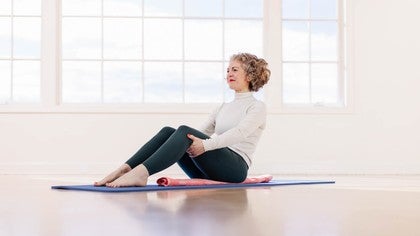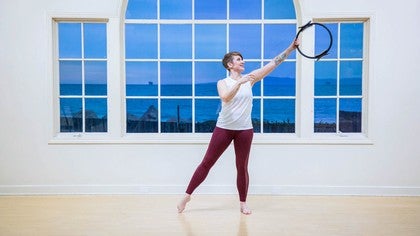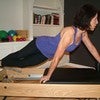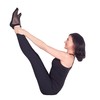Description
About This Video
Transcript
Read Full Transcript
Hi there, everyone. I'm Claire Sparrow. Welcome to class today. We're going to be doing a pelvic health class using a everyday, ordinary hand towels. So it's something that everybody can access at home, and we're gonna roll it and fold it in a few specific ways to give you direct feedback to help you with your pelvic health. So first of all, I'm gonna show you how we're gonna roll our towel to start with.
You're gonna lay it out lengthwise in front of you and roll it into a long sausage So we're rolling it out, and it's going to be in a beautiful roll and lay on the mat in front of you like that. Then we're gonna stand up, and we're actually going to take a moment to stand on the towel. Place the arch of your foot right at the back of your foot. So just where your arch meets your heel of both feet on the towel. So you feel just at the edge of your arch on the towel. Bring your arms by the side of your body.
And then let's go ahead and close our eyes for a moment. So you're gonna feel probably a little bit of oscillation in your body as it navigates the sensation of the towel underneath your feet. And that's normal, and it's actually really useful for us. I want you to allow your body to find a balance point where you feel everything stacked above that part of your foot that's standing on the towel. So perhaps that feels a little further back or further forwards than normal. Perhaps you need to release your kneecaps.
I always think about your kneecaps like the lids on a bottle. So bottle tops just need to be unscrewed a little bit. So can you unscrew your knees? And then allow your breath to travel throughout your body. Notice if the weight is distributed evenly between both feet, or do you feel more pouring into one foot than the other. And it's not not that you need to change it in any way.
It's about the curious observation of where you are right now in this moment. And imagining now that you're breathing through the pores of your skin. So the pores of your skin throughout your entire body. Through your feet, even through your hands. Maybe you need to think of the back of your neck if it feels like your head is moving forwards, if you breathe into the back of your neck, help your head to float and balance above your feet.
And we're gonna make a little mental note of how we feel in our bodies right now. Collect that information. Pop it on a shelf in your mind, ready to collect again at the end of class. Slowly letting the light come in through your eyelids, blinking your eyes open, and carefully step back off your towel. Pause for a moment.
Feel the sensations and new information coming in. Maybe you feel taller, maybe feel your feet are a little stronger underneath you. Great. Then we're gonna go ahead and pick up our towel. You're gonna keep it long, and you're gonna bring it around the back of your ribs. So bring it right up under your armpits, hold the ends of the towel and give it a very gentle pull. Not a big strong pull. Just a gentle pull.
Let your elbows relax down, and we're gonna breathe here. The feedback of your towel around your ribs is going to encourage you to breathe in to the back of your ribs. It sounds so obvious, but often we're not really getting the three-dimensional movement of our breath. And the towel is just a super simple way for us to find that. So breathing deeply into the back, into the sides.
And then when you're exhaling, exhaling fully and completely, Let it all completely empty until your inhale becomes a reflex. So your inhale just comes in. It just takes over. You will always breathe in. So allow the out breath to go and go and go and go and go.
And then the inhale just has to happen. One last time, deep, full exhale. Unlet the inhale just take over. Well done. Okay. So let's take the towel out now.
What we're going to do is come down onto the mat. You're gonna fold it into thirds. So you just fold it over itself into thirds. And then we're going to line our back and place that underneath our pelvis. So come and lie down on your back.
We're going to place it under your pelvis so it's vertical aiming for your tailbone to actually be off the towel. So it might feel a lot higher than you imagine. So looking for that point at the end of your sacrum where you can feel your tailbone just hanging there. Pause here for a moment. Your knees are bent.
Your arms are long by your side. The back of your ribs are open and falling into the mat. Often with our pelvic health, particularly our pelvic floor, it can be hypertonic. And we've done a class on that already, and this is also another great place to help release the tension that you might have in your pelvic floor. So imagine just letting gravity drop your tailbone over the edge of your towel and down towards the floor.
So your tailbone is moving away from your pubic bone. It's not that you're extending or moving. We're just letting the tissue go. You can imagine yawning your pelvic floor open, your tailbone down, you can imagine the petals of the flower opening in the sunlight, allowing your pelvic floor to lengthen. So now we're going to focus on the tailbone curling and uncurling. This is really different to a pelvic tilt or pelvic clock type movement because we're really looking for more of an internal sensation and internal queuing of your pelvic floor.
So can you isolate your tailbone curling in towards the center of your pelvis and then uncurling out? Curling in an uncurling. You can use your exhale to curl inhale to release exhale, inhale, release. And when you're releasing you can guide it out a wee bit further. Let it lengthen away. And then curl in almost like the breath pattern we did earlier where there's a natural recoil, a natural reflex to move.
Let's make this our last one, and then we're gonna expand on that by adding the sacrum curling on the tailbone leads. I and moves your sacrum You're rolling essentially along the feedback, the the length of your towel, starting each one with the tailbone curling in tailbone curling out. So you're massaging and awakening your pelvic floor from the inside movement. Each one lead with your tailbone. We'll do one more time curling and uncurling. Great job. Press there. Place your hands on your pelvis and walk your feet out to about shoulder width.
Focus on your right leg, and we're gonna roll your right leg in and roll your right leg out. So it's coming in and out And it's the top of your leg in the hip socket that I want you to focus on. Turning your thigh out. So the top of your thigh bones going out, and then the top of your thigh bones scooping in. So it's scooping out when your knee goes in and in as your knee goes out. Bit like a pendulum movement. We're gonna also be thinking here as your knee goes n of inflating your bottom.
So really opening up the back of your pelvis. We'll make this our last one. And then go ahead and rest there. Let's do the other side turning in and turning out. Think of the tops or the head of the femur in the socket, leading the movement, scooping it out when the knee goes in, scooping it in, as your knee goes out.
And don't be surprised if you feel a difference from one side to the other. Like, I so often say, We are not balanced through our pelvis. It's why we need to do this work. It's often why we have some challenges with our floor function due to that imbalance. Often, if you've had a birth injury, you're gonna know you've got a little tightness more on one side from that. So this is a great way to gently tease out the scar tissue and the imbalances that you have. Let's make this your last one, and we're gonna do a few where we do both legs together.
How we're gonna do that today is open them away from each other and close them in. So they open away, and then they close in. Opening and closing. When you open your legs, think of the end radius of your knees fanning out like butterfly wings, And then when they close, the butterfly wings close in towards your pelvic floor. It's also gonna help you to think about your pubic bone also all pinning to help your legs open.
You might find you get a little further. Last one here, opening and closing. Great job. Go ahead and goop your towel out, lie on your back for a moment, just notice how that feels, what's the difference in your body, maybe you feel much more clearly the two halves of your pelvis, which is really important. And then we're gonna go ahead and lengthen our towel out again. So We'd folded it into thirds. We're just gonna unfold it and then lie down.
So you've got your pelvis on it and your head on it. Sometimes when you get on, it gets a bit skew width. So you're just gonna make sure that you've straightened it out. Make sure your head's on and your pelvis is on. Feel both sides of your body.
And then edge your feet a little bit closer to your bottom, we'll do some bridging, arms long by the side of your body, standing into the footprints of your feet, and find the little curl of your tailbone, just the curl of your tailbone, and then your sacrum's gonna rise up towards your ceiling. Take a breath in. And then as you breathe out, let your tailbone start to uncurl to bring you down. Let's do one more just like that, feeling a little different way of initiating your bridging, finding your tailbone, finding that really strong sensation through the back of your pelvic floor. And then letting it gradually uncurl.
It's always a bit trick here on the way down. Let's go ahead and pause at the top this time. So we find our tailbone finer sacrum all the way up, peeling up your towel. Now on the way down, you're gonna lead with tailbone and a side to side movement. This is one of my absolute favorites.
This idea of weaving or wiggling down to how to increase the mobility, actually, further up your spine. Find your feet. Find your tailbone. And then, like, a snake moving through the sand, your tailbone leads down. Let's go ahead and just do one more of these. Tailbone sacrum rise, and then the tailbone leads through.
That's not gonna work if you're clenching your bottom so you might have to let go more than you are used to. Okay. Now we're gonna go to the top and pause again. So we come up, tailbone sacrum rise, feel open through the front of your hips. We'll do a little breathing exercise here to mobilize up and down through the thoracic spine. We inhale and lift our chest up and then exhale sink and spread it down.
Your pelvis is gonna stay quiet. Let's inhale up and then exhale melt it down. So you're gonna feel your ribs come up and open. Chest comes towards your chin, and then as you breathe out, they come away. This time, we're gonna start edging our way down. So you know the phrase, you know, one step forward, two steps back.
It's kind of like that. So we're gonna come up for one step, and then we're gonna go down a little bit more than up for one. And then town for your two steps. You can think about it as to vertebrae. You can just think about it as to steps, but each time we're gradually bringing our way down.
This is like having a massage releasing all the tension that you might have along your spine improving the mobility of your spine, really wakening up your pelvic floor, almost at the bottom now, maybe 2 more. Last one, really finding your pelvic floor at the back, and then all the way down and release. Pause there. Great. So now we're gonna come off our towel, scoop out from underneath you, and then just lie for a moment. Feel the difference.
Maybe you feel both sides of your ribs a little bit more. Feel the back of your head. Lots of lovely feelings. Let's take it underneath your pelvis horizontally now. So we're bringing it underneath. We're gonna do number 4 sign with your legs.
Arms a little wider, and we're gonna roll across your pelvis one side to the other. The great thing about the towel feedback is you've got something to follow. You literally just follow the line of your towel. Great. So come to the middle, peel your foot off the floor, and this is gonna deepen the movement and the release of tension through the back of your hip and the side of your hip. Great massage, great release for some of those cheeky influencer muscles that try and take over for the work of our pelvic floor. Let's come to the middle, float the foot down, uncross compare, and then we'll go ahead with the other side.
So you bring your leg across. Make sure that we're not on the ankle. You're just slightly above and you're rolling straight across from side to side. Often when we cross our leg in this position, we end up trying to push that knee away, which creates a twist in the pelvis. Just be where it is.
And that's fine. Peel your foot off the floor so we can deepen into the hip even more. Now if you've got prolapse or any other kind of pelvic floor dysfunction, when you take your foot off the floor. If you feel any downward pressure or any of your symptoms are aggravated, just keep your foot on the floor. Or you can get a little box, like even a shoe box to put your foot on to make it less load and pressure, but still gives you that deepening.
Let's come down uncross and pause there. Great. Let's go back to the other side. We're gonna have a bit of fun because we're gonna do the can now. So from that number 4, sign, roll across your pelvis and then reach your leg away and then fold in and roll across. So when you reach your leg away, I want you to reach along your inner thigh.
We sure inner thigh away and then folding in and rolling across. One last one. Reach, fold, and back to the center. And then we'll go the other way. So your leg is crossed over. Remember, it's not the ankle on the thigh.
It's just above. Roll across. Reach through your inner thigh. The back of your shoulders are staying on the mat and then coming back through. When you're rolling to the side, you've also got the option to roll your head in the opposite direction.
Can feel really nice and soothing for the back of your head and your neck. Reaching, reach your inner thigh. I think we should do one more. Often, the inner thighs are one of those areas that compensate so you can feel quite tight through there. Go ahead and uncross your legs take the towel light. Hopefully, that feels fabulous, and let's come up to some sitting now.
So we take the towel We're gonna come and sit with the soles of our feet together, and you're gonna hold the towel out and hold it with your palms facing your ceiling and your elbows in by your waist. Now I have always check myself in this position because I know my ribs want to push forward, so I bet you might be somebody like that too. So make sure your ribs stay in your body here. Elbows are in pull out firmly on the ends of the towel and release it. It's a bit like doing a dumb waiter.
We're pulling out on the towel. And when we're pulling out, I want you to think of your armpit coming forward and your arms spinning around. So arm pits forward, arm spinning around. This is really gonna help to open up across your chest. It's gonna help you to find the muscles connecting your shoulder blades and ribs into your back.
And as we pull out, can you slightly press on to the souls of your feet, which is gonna help you to set even taller in this position. You could do this with your legs crossed, of course, but when we cross our legs, what tends to happen is we're creating a little twist and rotation through our pelvis. And what we're trying to do. We're trying to bring balance back to our pelvis. So making sure we change across of our legs or we come into some different positions will be helped.
Thought. So let's go ahead now and take that feeling into the back of our body and use it now in our high kneeling position. So today, when you come up into high kneeling for thigh stretch, I want your knees to be dropped down underneath your hip socket but your shins are gonna be ever so slightly turns out. So long shins, but slightly feet wider than your knees. Pull out on your towel, remember the feeling you just had, and then we're gonna hinge back a little bit. When you hinge back, think back to the curling tailbone and sacrum forward experience you had in bridging. Because this is the same thing. So we're challenging it a bit more, but it's definitely the same thing.
We can go ahead now and arch her arms up when we come forwards. I love the sensation when we come forwards. It's like Ballin on the edge of something. And by balancing on the edge, the back of your pelvic floor is really weakening up here. Again, we've got the sensation of our ribs staying in our body, the awakening at the back of your shoulders.
This is gonna be your last one. Okay. Now we're gonna do some chi ring at the football or soccer. We're still in the same high knee leg with the knees under your hips and your shin slightly wider, but now we're gonna do, but like our mermaid movement, you're gonna aim to keep your head between your arms as you are up and over. Keeping your pelvis vertical is going to ask your pelvic floor to be awake and remain awake, sending your shins down as you go over, especially the shin you're moving away from.
So send your shin down as you go away from it. Once more either side, enjoying the awakening here. Great. Alright. Now we're gonna still use the long towel, lay it out, and you're going to sit with actually just one of your bottoms on it. So here, I'm putting my left bottom left sit bone left half.
And then the right half has dropped down slightly into the mat. Sometimes it takes a little bit of adjustment and fiddling around scooching about to find the balance between the two halves of your pelvis. So now your left is a bit like a wheel, and it's gonna turn back and turn forward. Gonna turn back, and it's gonna turn forwards. Your feet are just slightly apart. Your hands are holding the back of your thighs just as a little bit of support, and you're aiming to go straight back on the left And I say that because I could feel myself sort of turning a corner there.
So can you go straight back along and straight. Like, you're on a train track, and you're following that with the wheel of your pelvis rolling back. Enrolling forwards. Your right one is just just to worry about it. Just let it be. It will follow along a little bit, but your focuses on the left. Let's make this one, our last one, and then come off the towel. So give yourself a moment to compare the difference. You might feel some warming in the front of your head because, of course, We are deepening your thi bone into the socket as well as we do this.
And then, of course, let's even out place your right bottom, right half of your pelvis, feel maybe the sit bone can be on there. Feet slightly apart. And then we're rolling back focusing on the right wheel turning and rolling. Rolling back, rolling forwards. If you want to cue your breath for this, it's gonna be exhale turning back.
Inhale coming up. Exhale turning back. Inhale turning forwards. Follow the straight line of the towel again. Like we said on the other side, there can be a tendency to veer off or try and go too far. And we lose that motion of the wheel turning on the track.
It's quite normal also to feel almost a staccato movement. Like, there's clicks and pops and funny things happening, and that's you just experiencing the tension the buildup. Much like we know when we have tension in our shoulders and we want to massage out the knots there, it's the same through our pelvis. So we'll make this our last one. And then go ahead and bring it now into the middle. So you've got it set so that you've got your pelvis right in the center. You can feel your tailbone.
You're sitting as upright as you possibly can. If you feel uncomfortable or it's too restricted in the front of your hips, just sit on a chair. You can do exactly the same thing. Hands at the back of your thighs and bring your awareness back to where we began with our tailbone floating. You're allowing your tailbone to curl and then your sacrum to follow.
Tailbone and sacrum. Really bringing it towards your pubic bone and away from your pubic bone, tailbone, curling, untapped, maybe how far you can go. Once you get used to the range being initiated by your tailbone, you can challenge that by going a little bit further. We're gonna go ahead and do one more. You're doing great.
We're working so deeply into our pelvic floor here. Let's come off the towel, and we're going to come up to standing to finish our class today. So laying your towel out along your mat in front of you and then bring yourself to standing. We're going to do bird on a branch. So at the beginning, we had the arch, the back of our arch on the towel.
Now we're gonna have our toes. And I want to see you really curl your toes over. Like your toes are pulling the towel towards your heels. So can you stay tall and curl and pull towards your heels, curl and pull. Twice more just like that.
Use your exhale to help you. Exhale to help you and rest there. Now place your hands on your hips. We're gonna make that curl and we're gonna keep it there. So curl make a really good curl. Make sure your little toes are curling too.
Sometimes they get forgotten about, and they're very important. For your pelvic floor. So let's go ahead now and bend and stretch. So we're staying in the bird on a branch, It might feel quite strong through the arches of your feet. You might even feel that upward doming and lifting of your pelvic floor or a sensation inside your pelvis. So as we're pressing up, breathe out. Breathe in as you go down.
Breathe out as you come up once more. Breathe in and breathe out. Great job uncurl your toes. Stand on the floor. Compare the difference. Isn't that amazing to feel active in your arches?
We're gonna have our arms by our side. You're gonna close your eyes for a little moment, and we're gonna recheck in with ourselves. At the beginning of class, we made a mental note and we put it on a shelf. Take it off the shelf right now. So you can compare.
How are you balanced in your body right now? How are you balanced in your pelvis? Right now, or the learnings that you can take away into your everyday life or other classes that you're doing. What did you discover about yourself that you want to explore a little bit more. And give yourself a little moment of gratitude for taking this time out today.
To appreciate yourself and to take care of your pelvic health. And then let's open our eyes together. Thank you so much for joining me in class today. It's been a pleasure as always to be here and teach you, and I look forward to seeing you in another class soon.
Intermediate Mat Workouts: 30-Minute Classes
Comments
You need to be a subscriber to post a comment.
Please Log In or Create an Account to start your free trial.





















